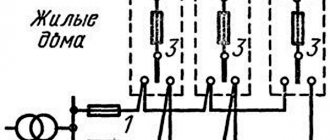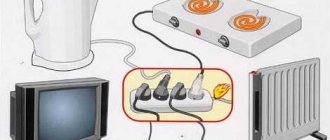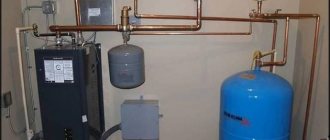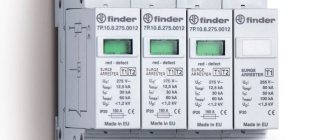Replacing an old electric meter with a new one often provokes a number of questions about the need to install additional equipment: a circuit breaker or a switching device. Particularly acute is the question of whether to install an input machine before or after the meter. A complete answer to this is given by the regulatory documents of the PUE.
In Soviet times, package switches were installed in floor switchboards at the input, and today they are still installed in many places. Such outdated means of protection are dismantled, since they are no longer suitable for full operation. The replacement process raises questions about installing additional equipment.
The batch switches are replaced by an introductory automatic machine. The name gives the impression of special equipment with special functionality, but it is just a circuit breaker.
The need to install a switching device according to the PUE
Voltage relief devices are necessary for the safe installation of a new or replacement of an old electric meter. This is stated in paragraph 7.1.64 of the PUE: “For the safe replacement of a meter directly connected to the network, a switching device must be provided in front of each meter to relieve voltage from all phases connected to the meter.”
Thus, installation of a switching device in front of the meter is mandatory. It is also necessary to install an input machine before the meter.
Where to place the introductory machine before or after the counter?
The PUE clause 7.1.64 indicates the installation location of the input protective device - in front of the electricity meter. This is necessary to safely replace the electric meter. If there is a three-phase power supply, the circuit breaker must turn off all supply phases at the same time.
Due to the installation location, unauthorized replacement of the machine, and even more so, removal of the seal from the panel in which it is located, will lead to charges of theft of electricity.
Reference! If a circuit breaker located in a sealed box fails, its replacement is possible only with the agreement of the electric company.
In some situations, it is advisable to install two electrical panels, one of which will contain an input circuit breaker and an electric meter, and the second will contain group circuit breakers, voltage relays and an RCD.
Purpose of the introductory machine
The need to install a circuit breaker is determined by the protective system of electrical wiring from overload and the danger of short circuits. The input machine blocks the possibility of a complete blackout at home.
The input circuit breaker protects the wires from overheating, which can cause a fire hazard. The cause of cable overheating is usually long-term loads on the entire electrical network of the facility. The circuit breaker contains a thermal and electromagnetic release that prevents overheating of the wires. The switching device is necessary to de-energize the building in the event of repairs or local network failures.
Actions when turning off the machine
Inexperienced users, when the network is disconnected, automatically rush to restore the voltage supply by turning on the device. But it is not recommended to turn on the device without establishing the reason for the shutdown.
The machine may operate for the following reasons:
- overheating of sockets and switches as a result of loose contact;
- excess load due to the simultaneous activation of several powerful consumers;
- poor contact in wiring connections.
To determine the malfunction, you need to inspect your home network, make sure there is no heating or smell of burnt plastic. If the heating point is established, the necessary repairs are carried out.
When triggered by excess load, it is necessary to limit the number of switched on consuming devices. The device turns on after a complete check of the network and the cause of the shutdown has been eliminated.
The device may operate due to its failure, which is determined by visual inspection of the switch. If there is heating of the contacts, traces of thermal deformation, charring of the terminals, the machine must be replaced.
Serviceable and correctly selected circuit breakers will ensure normal operation of the home electrical network, eliminating the risk of damage to household appliances. But if the owner does not have electrician skills, it is worth contacting a qualified electrician to install or replace the machines.
Types of input devices
There are two types of protection devices:
- 2-pole in single-phase network;
- 3-pole in a three-phase network;
- 4-pole in a three-phase network.
Most electricians prefer to install a four-pole circuit breaker in a three-phase network. Because in this case, when overheated, the neutral conductor is disconnected along with the linear conductors. Sometimes you can find a three-pole circuit breaker located at the input, during which only linear conductors are disconnected.
Advice: you should choose a device that is triggered when the norm is exceeded by 1000A: this is how much it can withstand.
How to properly connect an electric meter and machines
To ensure the safe operation of your shield, follow these simple rules:
- use single-wire monolithic wire for installation;
- when using flexible wire, use ferrules;
- use unbreakable jumpers;
- use a U-bend to increase the contact area.
Using lugs on flexible wire
For wiring panels, electricians often prefer a flexible wire with a stranded core of type PV-3 or PuGV. It is easier and easier to work with than with a monolithic core. But there is one peculiarity here.
The main mistake that beginners make in this regard is connecting a stranded wire to the machine without termination. If you clamp a bare stranded wire as it is, then when tightening the strands are squeezed and break off, and this leads to loss of cross-section and deterioration of contact, and the contact itself weakens over time.
Experienced “specialists” know that it is impossible to tighten a bare stranded wire into a terminal. Therefore, if a stranded wire is used during installation, then NShV or NShVI lugs must be used to terminate it.
In addition, if there is a need to connect two stranded wires to one terminal of the machine, for this you need to use a double tip NSHVI-2. Using it, it is very convenient to form jumpers for connecting several group circuit breakers.
Using a U-Bend
To connect the cores of outgoing wires and cables to the machines, we remove the insulation from them by about 1 cm, insert the bare part into the contact and tighten it with a screw. According to statistics, 80% of electricians make connections this way.
The contact at the junction is reliable, but it can be further improved without wasting time and money. When connecting cables with a monolithic core to circuit breakers, make a U-shaped bend at the ends.
This formation of the ends will increase the area of contact of the wire with the surface of the clamp, which means the contact will be better.
The inner walls of the AB contact pads have special notches. When the screw is tightened, these notches cut into the core, thereby increasing the reliability of the contact.
Using continuous jumpers
If there is a need to connect several machines standing in the same row from one source (wire), a comb bus is ideally suited for this purpose. But such tires are not always at hand.
How to combine several group machines in this case? Make a homemade jumper from cable cores. To do this, use pieces of wire of the same cross-section, or better yet, do not break it along its entire length.
How to do it:
- Without removing the insulation from the wire, form a jumper of the desired shape and size (according to the number of branches).
- Then we strip the insulation from the wire at the bend to the required length, and we get an unbreakable jumper from a single piece of wire.
Principle of operation
Usually a limit is set on the electricity consumption of a certain house or apartment. It is indicated when concluding an agreement between the energy supplier and the homeowner. Thus, if the design documentation indicates a consumption level of 25A (amps) in a single-phase network, then this means limiting the energy to 5.5 kW. The input circuit breaker will automatically de-energize the house if the limit is exceeded - this operating principle allows you to minimize the likelihood of a fire hazard.
Selection of circuit breaker rating
The rating of the input circuit breaker must be greater than the rating in apartment circuits. This allows you to avoid turning off all electricity if the protection works in only one of the apartments. The machine is placed on a meter with a standard size of 25 amperes.
The maximum allowable limit is 63 amps, and is usually only found in switchgear in high-rise residential complexes. How many amperes are needed is usually calculated based on the number of apartments.
Installation of an introductory machine
It doesn’t really matter whether the machine is installed after the meter or before it. The only point is that installation up to the electric meter requires mandatory sealing. Supplementing the meter with installed fuses is also necessary.
Important! The filling procedure is carried out using a special box. Otherwise, you need to purchase special panel equipment with a cell in which you can install an automatic input switch.
When positioning, it must be taken into account that the input conductor is laid exactly to the circuit breaker and is susceptible to the following loads:
- lighting;
- sockets;
- number of connected electrical appliances;
- Technical equipment.
All loads must be summed up to select a three-phase input device, which is needed to avoid overheating of the wires.
How to properly connect the machine after the meter
A correctly connected VA after the meter will provide reliable protection for the wiring of an apartment or cottage. This will protect residents from electric shock and prevent the building from catching fire.
Until recently, fuses or automatic plugs were used as protection devices.
When replacing an electrical panel, protection is installed that meets the requirements of the PES. An automatic machine is installed on each line. It ensures that a specific line is switched off in an emergency.
Typical scheme
Let's look at a typical circuit diagram for connecting circuit breakers in a switchboard. For a single-phase connection to a house or apartment at 220 V, a circuit breaker is mounted on each line. This protects a separate line supplying lighting and sockets.
The cable that supplies voltage to the process equipment is protected by an RCD.
All phase conductors will be combined and connected to the VA. Do the same with neutral wires. The wires from the general circuit breaker go to the electric meter. The mains voltage is supplied to the meter through the switching device.
With three-phase voltage, the connection diagram is similar to single-phase. The difference lies in the uniform distribution of the load across the phases. And distributing it among the machines after the counter.
Replacing a packet switch with an automatic one
Dismantling of old equipment is usually caused by burnt contacts in old-style houses. It is impossible to repair such a breakdown, which is why it is necessary to replace the batch switch with a modern automatic analogue.
There are two methods used for repair:
- The burnt switch is dismantled, but the wires are simply twisted together - the shield continues to work, but has no protection against overheating.
- The switch is replaced with a circuit breaker.
The switching circuit of the metering device does not change: the selected input machine is connected in the same way as its predecessor.











